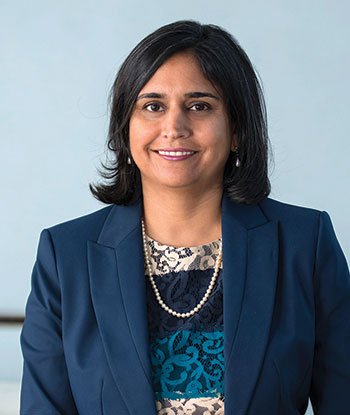 |
|
Photo by Rick Friedman Tejal Gandhi, president of The National Patient Safety Foundation |
The National Patient Safety Foundation’s recent report, “Free from Harm: Accelerating Patient Safety Improvement Fifteen Years after ‘To Err Is Human,’ ” proposes greater oversight, communication, funding and support to help improve patient safety. This month, we talk to the foundation’s President and CEO Tejal Gandhi, M.D., MPH, CPPS, to see how health facilities professionals can fit into the patient safety picture.
How important to patient safety are health facilities professionals such as facilities directors, biomedical engineers and environmental services managers?
Health care facilities are complex environments that bring together a wide range of people with diverse needs, skills and experiences — they are microcosms of our communities. That leaves a big opportunity for risk as well as for making sure things go right.
For example, biomedical engineers need to be involved in the selection, implementation, monitoring and maintenance of complex equipment. A big part of this requires good communication with the clinical teams, to know when something is not working as expected. Likewise, environmental services teams are crucial to preventing the spread of health care-associated infections. They need education, training and tools to do their work, and management needs to make sure they understand how important their jobs are.
Often, the best ideas for improvement come from those who do the work every day, and facilities professionals should be present on all safety- and quality-related committees to make sure their perspective is presented and understood.
Facilities professionals can see hazards that clinicians may not; for example, fall risks or poorly placed hand-hygiene stations. They also hear about things that clinicians may not hear, like a sick or frail patient’s experience in navigating a lengthy journey from the radiology department to the orthopedic surgery clinic. That facility manager may work with the patient safety committee to figure out a way to provide escorts and wheelchairs more easily.
I was encouraged recently to see several health technology management professionals pursuing certification in patient safety through our Certified Professional in Patient Safety program, and I think this is something we’ll see more of in the future.
The Gandhi file |
| CV • President and CEO of the National Patient Safety Foundation (NPSF), the NPSF Lucian Leape Institute and the Certification Board for Professionals in Patient Safety • Board-certified internist and associate professor of medicine at Harvard Medical School, Boston • Former executive director of quality and safety at Brigham and Women’s Hospital, Boston • Former chief quality and safety officer at Partners HealthCare, Boston Accomplishments • Frequent speaker and member of national and regional committees and boards • Recipient of the John M. Eisenberg Patient Safety and Quality Award for her contributions to understanding the epidemiology and possible prevention strategies for medical errors in the outpatient setting Education • MD and MPH degrees from Harvard Medical School and the Harvard School of Public Health • Undergraduate degree in biochemistry from Cornell University, Ithaca, N.Y. |
What can they learn from the National Patient Safety Foundation’s (NPSF’s) recent report, “Free from Harm: Accelerating Patient Safety Improvement Fifteen Years after ‘To Err is Human’ ”?
A major theme of the report is that we need to move toward total systems safety — having a health system, and health care organizations, that really think about systems design, the inevitability of human error, human factors engineering, safety culture, and error reporting and analysis. That kind of system involves everyone in patient safety — whether by reporting a safety risk, speaking up to a clinician who may be doing something that causes risk, or suggesting better workflows to make work easier and safer for clinicians and patients.
Now, that doesn’t happen overnight, and the report makes clear that strong leadership is needed to create and sustain a culture of safety.
What role would they play in the total systems approach to patient safety that’s described in the report?
Facility directors and managers can contribute to total systems safety by learning about patient safety science and encouraging systems thinking among their teams. Again, no one suggests that this is easy. Facility directors have so much to worry about — from natural disasters to outside threats. But this shouldn’t be considered “one more thing to do.” It should be ingrained into facilities teams so that, ultimately, it contributes to the value they bring to the organization.
Strong leadership allows for and encourages education and training at all levels. That includes facilities professionals, environmental services, biomedical engineers as well as clinicians and support staff. This is part of what our recent report suggests — that leaders set the tone for an organization’s culture. Leaders are in a position to ensure that everyone has baseline training in safety and can speak up when something doesn’t seem right.
How can they help with specific challenges such as patient falls, hand hygiene and alarm fatigue?
Our report doesn’t address specific safety issues, but I will say that the total systems approach encourages the kind of thinking that can bring about solutions to these problems from far corners. If, for example, a biomedical engineer receives some additional training in human factors, maybe he or she can help to design processes and protocols that reduce alarm fatigue. Or maybe someone working in environmental services will see a common pattern in patient falls. Or a facilities manager might suggest a redesign to allow a better, safer workflow for clinical teams. The ideal organizational culture is one that encourages that kind of thinking and rewards people for speaking up — even if it’s just to say ‘thank you.’
How important are architects and interior designers to patient safety?
I am not an expert on hospitals and health facility design, but I know that health care organizations are paying greater attention to design these days than in the past.
Several years ago, NPSF awarded a research grant for a project that looked at whether the design of patient rooms could help to reduce falls. It was a fascinating study that involved a hospital falls committee, an architectural firm and the engineering researchers. It was a great example of using teamwork to identify the root of the problem and to design potential solutions. And, it has implications beyond the hospital as well.
Some have suggested that building projects, which don’t come along often in health systems, can be used as a springboard to improve culture. It’s an interesting way to look at things — and, again, it requires hearing from all those involved, including patients and the community.
Have the growth of smaller, off-campus health care facilities added to patient safety challenges?
Absolutely. As the “Free from Harm” report notes, there are 35 million hospital admissions each year, but a billion outpatient encounters. So, we know most of the health care provided in the U.S. is provided in ambulatory facilities, including in the home, long-term care facilities and rehab facilities. Most of the patient safety work, however, has been done in hospitals.
There is a strong need to ramp up outpatient facilities and ambulatory surgical centers. A good starting point is by educating the staff — again, health care workers, no matter the setting, can benefit from learning about safety science, systems design and human factors. Learning can help to improve workforce safety as well as patient safety.
With which hospital colleagues should health facilities professionals interface to ensure that their voices are heard with regard to patient safety?
I would encourage health facilities professionals to make sure that they are represented on all key safety and quality committees. If they don’t know where to begin, they can contact the chief quality and safety officer, the risk management team or the patient safety team. Workforce safety is an essential ingredient to patient safety, so facilities professionals also should be involved in human resources and occupational health and safety activities.
Mike Hrickiewicz is editor of Health Facilities Management.





